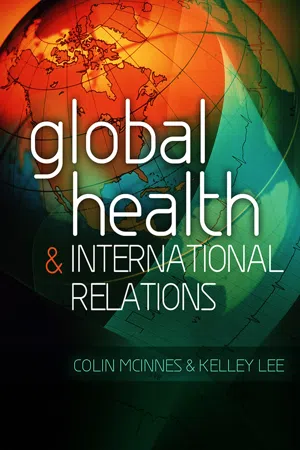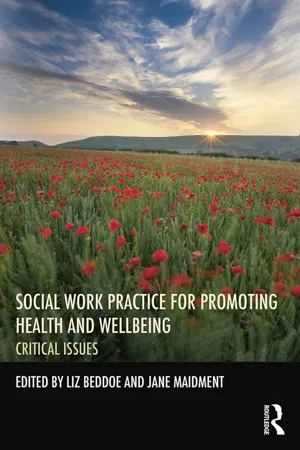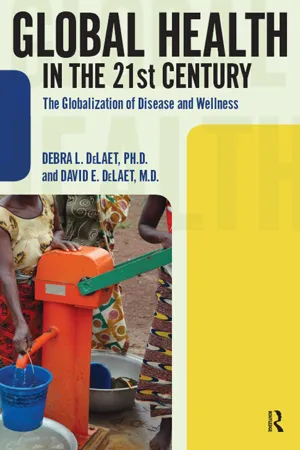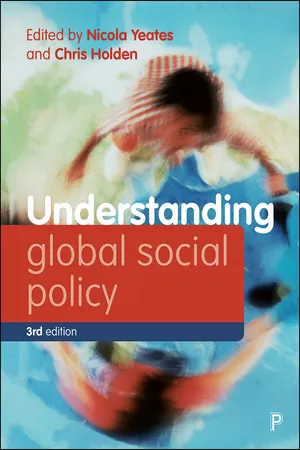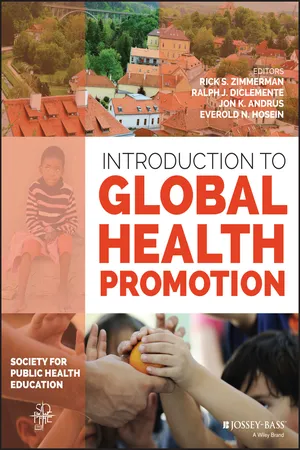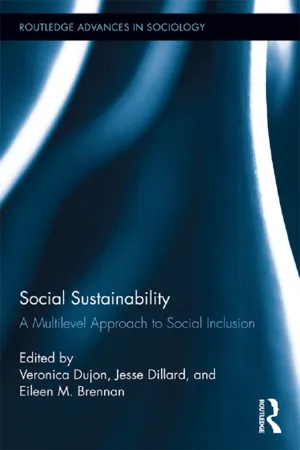Social Sciences
Global Health and Development
Global health and development refers to the interconnected efforts to improve health outcomes and well-being on a worldwide scale, particularly in low- and middle-income countries. This field encompasses initiatives aimed at addressing health disparities, promoting access to healthcare, and advancing sustainable development goals. It involves collaboration between governments, organizations, and communities to tackle complex health challenges and promote equitable development.
Written by Perlego with AI-assistance
Related key terms
12 Key excerpts on "Global Health and Development"
- eBook - ePub
International Development
A Global Perspective on Theory and Practice
- Paul Battersby, Ravi Roy, Paul Battersby, Ravi Roy(Authors)
- 2017(Publication Date)
- SAGE Publications Ltd(Publisher)
17 Global Health and Development PracticeDebbi LongPaul KomesaroffElizabeth KathIntroduction
The term ‘Global Health’ encompasses a range of concepts and activities, including concerns and practices relating to health that cross national borders and are implemented in multiple settings across the world (Brown et al., 2006; Koplan et al., 2009). The Executive Board of the Consortium of Universities for Global Health has argued for a ‘unified definition’, as follows:Global Health is an area for study, research, and practice that places a priority on improving health and achieving equity in health for all people worldwide. Global Health emphasizes transnational health issues, determinants and solutions; involves many disciplines within and beyond the health sciences and promotes interdisciplinary collaboration; and is a synthesis of population-based prevention with individual-level clinical care. (Koplan et al., 2009: 1995)This definition entails a radical reformulation of previous ways of understanding the nature of health issues across international borders, especially in its call for multidisciplinary input into health solutions. The approach overcomes many of the criticisms to which the erstwhile concept of ‘international health’ was subjected, and it has been linked to progressive social and political movements and causes.While recognizing the value of the shift from ‘International Health’ to ‘Global Health’, it is crucial also to explore the limitations and pitfalls associated with it. This chapter provides a critical overview of Global Health as an academic discipline and practice and the key developments that have taken place within Global Health discourse over the decades since the term emerged. It discusses both the strengths and limitations of current Global Health approaches and goes on to critically examine developments over recent decades, such as the concept of the ‘social determinants of health’. Finally, the chapter proposes that a way forward in response to these limitations is to mobilize the achievements of Global Health discourses in the service of novel and fecund practices based simultaneously on a global commitment to social and political change, respect for local cultures and knowledge, and respect for those who work within them. - eBook - ePub
- Adam Feather, David Randall, Mona Waterhouse(Authors)
- 2020(Publication Date)
- Elsevier(Publisher)
Global healthBabulal Sethia, and Parveen Kumar- Introduction
- Millennium and Sustainable Development Goals
- Global burden of disease
- Poverty
- Water and sanitation
- Organizations and the global health agenda
- Education
- Maternal and child health
- 281
- Accidents and trauma
- Conflict and catastrophe
- Economics and politics in global health
- Social determinants of health
- Human rights and the value of engagement in global health
- The healthcare workforce
- Medical electives
Core Skills and Knowledge
Global health can be defined as ‘an area of study, research and practice that places a priority on improving health and achieving equity in health for all people worldwide’. It recognizes that health is determined by challenges that transcend national boundaries, and looks at healthcare needs across the world as well as within individual nations. Such needs are complex, may be triggered by natural disasters or armed conflict, and must be addressed using a multiprofessional approach.Efforts to improve global health are championed by non-governmental organizations such as the World Health Organization (WHO), the United Nations Children’s Fund (UNICEF) and the World Food Programme, alongside individual charities and local government health systems, and interventions are often directed by international targets such as the United Nations’ Sustainable Development Goals.Opportunities for developing an understanding of global health include:- • engaging actively in debates about the global economic and political determinants of health
- • considering the evidence for community-level interventions in improving health outcomes
- • travelling to see medicine being practised in a radically different context (e.g. as part of a medical school elective, see p. 283), and reflecting on the successes and ongoing challenges of local healthcare provision.
- eBook - ePub
- Babulal Sethia, Parveen Kumar, Babulal Sethia, Parveen Kumar(Authors)
- 2018(Publication Date)
- Elsevier(Publisher)
Chapter 1.3 .Global health
Some commonly used definitions of global health include:- ▪ ‘Health issues where the determinants circumvent, undermine or are oblivious to the territorial boundaries of states, and are thus beyond the capacity of individual countries to address through domestic institutions. Global health is focused on people across the whole planet rather than the concerns of particular nations. Global health recognises that health is determined by problems, issues and concerns that transcend national boundaries’ (HM Government, 2008).
- ▪ ‘An area for study, research, and practice that places a priority on improving health and achieving health equity for all people worldwide’ (Koplan et al., 2009 ).
- ▪ ‘Health problems, issues, and concerns that transcend national boundaries, may be influenced by circumstances or experiences in other countries, and are best addressed by cooperative actions and solutions’ (US Institute of Medicine, 1997).
Global health is an interdisciplinary field which encompasses disciplines such as law, economics, history, social and behavioural sciences, engineering, biomedical and environmental sciences and public policy.Global health is relevant because many health care professionals train and practice both in their country of origin and in foreign lands.Why is global health relevant?
International clinical placements
The globalised world
Each year, around 3 billion airline passengers fly within and across borders. Infectious disease epidemics/pandemics and mass migration are all major issues requiring a globalised approach to health policy and leadership. The Internet and the increasing connectivity of individuals across the globe in the 21st century provides a reminder of the importance of being a ‘global citizen’, and improving the health of everyone in the global, interconnected village. - eBook - ePub
- David Phillips, Yola Verhasselt(Authors)
- 2002(Publication Date)
- Routledge(Publisher)
delicate interrelationship for many years (Learmonth 1988).Figure 1.1 Interaction between human activities and the physical and biological environmentSource: WHO (1992a)Development, like health, is equally an elusive concept. Many economic definitions see development as being a phenomenon measurable by increasing per capita income or gross national product (GNP). While development does, undoubtedly, have a quantifiable fiscal element, it has many more subtle elements, to do with distribution of resources, access to opportunities (services, jobs, housing, education) and political/human rights. Seers (1969) sees development as of necessity increasing aspects of human dignity—which means access to basic needs: food, shelter, a job—and also political participation. Development is therefore generally understood as the process of improving the quality of all aspects of human life (WHO 1992a).A complex interrelationship exists between health and development; it is certainly not a one-way relationship, and there are surely reciprocal and synergistic elements to it. It has long been acknowledged that the health status of the population in any particular place or country influences development. It can be a limiting factor, as generally poor individual health can lower work capacity and productivity; in aggregate in a population, this can severely restrict the growth of economies. On the other hand, economic development can make it possible to finance good environmental health, sanitation and public health campaigns—education, immunization, screening and health promotion—and to provide broader-based social care for needy groups. General social development, particularly education and literacy, has almost invariably been associated with improved health status via improved nutrition, hygiene and reproductive health. Socio-economic development, particularly if equitably spread through the population—although this is rarely the case— also enables housing and related services to improve. The classical cycle of poverty can be broken by development. - eBook - ePub
- Colin McInnes, Kelley Lee(Authors)
- 2013(Publication Date)
- Polity(Publisher)
CHAPTER ONE What is Global Health?There is something ubiquitous about the term ‘global health’.1 In a little over a decade, it has come into common usage not only within scholarly circles, but as part of key policy debates about how health care services should be financed and delivered. Health cooperation is now no longer described as merely ‘international’ but ‘global’, as the scope for national responses to address a growing number of health issues (especially those with crossborder implications) is seen to have diminished in the face of globalization. Global health, in other words, has arisen in response to ‘real world’ developments that have led to the closer integration worldwide of the determinants and outcomes of human health.At the same time, however, the use of the term global health can be understood, not only as a reflection of a profound shift in the ingredients that influence health policy, but as a concept that has contributed to that shift. In the creation and use of the term ‘global health’, a multiplicity of trends have been given a shared meaning which encourages us to see the world differently. Statements such as ‘health is global’ (Department of Health 2008a), therefore, are not simply a reflection of an external reality, but a rallying call to reinterpret how we understand health in a particular way. Health as global, in this sense, is normative in its framing or social construction of the subject.This chapter explores these ideas in three main sections. The first identifies the orthodox explanation for global health as a product of, and response to, new trends, notably globalization and its impacts on health. The second discusses the manner in which global health is subject to different meanings because it occupies contested terrain. The final section argues that the manner in which we use the term global health is not value-neutral, but promotes certain issues, interests and institutions over others. - eBook - ePub
Social Work Practice for Promoting Health and Wellbeing
Critical Issues
- Liz Beddoe, Jane Maidment, Liz Beddoe, Jane Maidment(Authors)
- 2013(Publication Date)
- Routledge(Publisher)
3 Globalisation, Social Work and Health
Paul Bywaters DOI: 10.4324/9780203112816-3Chapter Objectives- To explore different understandings of globalisation;
- To discuss key global health issues and their implications for social work;
- To outline some possibilities for practice informed by an analysis of globalisation.
Introduction
Social justice is a matter of life and death. It affects the way people live, their consequent chance of illness, and their risk of premature death. We watch in wonder as life expectancy and good health continue to increase in parts of the world and in alarm as they fail to improve in others. A girl born today can expect to live for more than 80 years if she is born in some countries – but less than 45 years if she is born in others…. These inequities in health, avoidable health inequalities, arise because of the circumstances in which people grow, live, work and age, and the systems put in place to deal with illness. The conditions in which people live and die are, in turn, shaped by political, social and economic forces. (Commission on the Social Determinants of Health (CSDH), 2008 , Preface)The essence of this chapter can be found in this statement. Health is a global issue. Profound injustice is apparent in differences in health and life expectancy between (and within) countries. Health should be a central concern for social workers because it is an issue of social justice, affecting the way people live It is also a central social work concern because it is primarily social factors – the social determinants – which shape people’s health and their life chances generally. The disadvantaged social conditions in which most social work service users live and the discrimination they often face are reflected in their common experiences of poor mental and physical health. Their poor health, in turn, further undermines their opportunities for securing the resources they need for happy, successful and healthy lives. The political, social and economic forces which shape these social conditions are partly locally created and maintained but they are increasingly subject to global forces which transcend national boundaries and to globalisation (Bywaters, 2009 - eBook - ePub
When People Come First
Critical Studies in Global Health
- João Biehl, Adriana Petryna, João Biehl, Adriana Petryna, João Biehl, Adriana Petryna(Authors)
- 2013(Publication Date)
- Princeton University Press(Publisher)
In attending to the implementation of policies and their embodied responses, the book examines the value systems undergirding incentives, expertise, technologies, measurements, and outcomes. In the process, models of causality and claims of success are scrutinized, and new possibilities for research, policy, and care are brought into view. What or who must be valued in order for knowledge to count as global health science, and what or who remains subjacent or unaddressed? What forms of patienthood and political belonging take shape when new medical technologies are deployed via global health interventions? How can donors and governments be held accountable in the long run, especially in financially volatile times? How can human rights and equity concerns be integrated into global health research and policy? These unanticipated problems and questions have to be addressed now, as lifesaving imperatives are being converted into pharmaceutical and geopolitical capital.People’s everyday struggles and interpersonal dynamics have a way of eluding expert projections and short-lived experimental approaches. The task of the social sciences and humanities in the field of global health is to break through these projections (Whitmarsh, this volume) and to produce different kinds of evidence as we approach bold challenges such as historical health disparities and the pharmaceuticalization of health care. We must also engage crucial questions about the role of the state and the market in global health design and delivery, and investigate what happens to citizenship when politics is reduced to survival—all while maintaining a deep and dynamic sense of people in local worlds (Biehl and Petryna, this volume).A historical and critical assessment of global health knowledge and tools combined with dedicated ethnographic research is a vital antidote to the quick theoretical fix that has taken its place in our culture alongside the quick technical fix. For the contributors to this book, people come first. Upholding the right to microanalysis, our chapters bring into view the fields and ideas that people invent and live by: call it contrapuntal knowledge. This respect for people, their travails and aspirations—combined with attention to how health policies are put together, take institutional hold, and function in the messiness of idiosyncratic human milieus—makes a great deal of difference in the kind of knowledge we produce. - eBook - ePub
Global Health in the 21st Century
The Globalization of Disease and Wellness
- Debra L. DeLaet, David E. DeLaet(Authors)
- 2015(Publication Date)
- Routledge(Publisher)
Part III The International Relations of Global HealthPassage contains an image
Chapter 6 Economic, Ethnic, and Gender Inequities in Global Health
DOI: 10.4324/9781315634425-9Introduction
Different levels of economic development and inequitable distribution of economic resources fundamentally shape health outcomes for individuals, communities, and populations across the globe. Additionally, inequities in individual and population health stem from a variety of cultural, political, and social variables. Gender norms also contribute to inequities in global health. Accordingly, this chapter explores inequities in global health at multiple levels: territorially based inequities among different regions and countries of the world, poverty-based inequities that cut across territorial borders, racial and ethnic inequities within countries, and gender inequities in the health status of men and women.Economic Development and Territorially Based Inequities in Global Health
National Economic Development and Population Health
The achievement of higher levels of national economic development tracks closely with significant improvements in population health. The growth of the modern state in the 20th century was accompanied by unprecedented improvements in human health. As Richard Skolnik notes, “It is an astonishing fact that half of all the increase in human life expectancy over recorded time occurred in the 20th century.”1 It is not a coincidence that this century involved the buildup of public infrastructure that either directly or indirectly contributed to improved living conditions and health outcomes among populations living in areas that attained high levels of economic and social development. Millions of lives have been saved due to large-scale public health interventions, including the creation of public water systems and public sewers.2 - Nicola Yeates, Chris Holden, Yeates, Nicola, Holden, Chris, Nicola Yeates, Chris Holden(Authors)
- 2022(Publication Date)
- Policy Press(Publisher)
A key challenge for global health governance and health policies is to engage with national and global regulation and redistribution for health, where corporate actors and interest groups may influence health policy priorities groups. Global pandemics also remind us of the importance of global health cooperation and engagement with normative policies at the heart of global health policy.The need to engage with the underlying SDH is recognised both in the context of a focus on UHC as well as with respect to interlinkages between health, poverty and inequalities. To address the SDH and ensure access to healthcare for all, global health policies will need to focus more on the redistribution of resources both between and within countries.Finally, just as in other policy areas, global health policy formation is not merely a matter of technical concern or biomedical facts, but is embedded in values, power relations, politics and institutional and cultural priorities.Summary• Global health policy is an arena for public policy decisions and debates on how global policies support health systems, social, environmental and political determinants of health and health protection and security.• Global health policy tends to be defined as predominantly a development issue, where global health policy applies to the Global South and/or as a remedy to impacts from broader trade and commercial policies.• Despite the pandemic, global cooperation to address crucial health systems issues, determinants of health and regulatory needs in the context of global health policies and globalisation, including the erosion of the WHO’s resource base (which affects its capacity to undertake public health and regulatory work) has weakened.• Private foundations and NGOs play a stronger role in agenda-setting; commercial actors and their forums also play a stronger role in global policy-making.Questions for discussion• How are global health policies both different from and similar to other areas of global social policy?•- eBook - ePub
- Heather Widdows, Nicola Smith(Authors)
- 2013(Publication Date)
- Routledge(Publisher)
I begin by briefly introducing core features of the concept of public health and the emerging field of public health ethics. I claim here that justice is a core guiding moral principle for public health in two ways: first, as an ethical and procedural principle in the implementation of public health policy, and second as a substantive and social principle to guide the moral purpose of public health. This second aspect of justice for public health becomes the primary concern of the rest of the chapter. Public health and social justice, however, are both concepts that have been traditionally restricted to the domestic sphere and thought inapplicable at the global level. The second half of the chapter is therefore devoted to asking whether there are any good reasons to limit public health, governed by the moral pursuit of social justice, to the domestic sphere. I explore five of the most plausible reasons why public health should be limited to the domestic sphere, each of which relates to a feature of public health practice, and find each one wanting. I conclude, therefore, that global public health action ought to be governed by the moral concerns of global social justice.Public health and social justice
The concept of public health, although contested in some circles, orientates around two intuitively core features; ‘health’ and the ‘public’. The concept of ‘health’ is notoriously slippery but one which public health eludes somewhat because it is primarily concerned not with health per se but with securing the conditions in which people can be healthy and thereby preventing health problems. The conditions in which people can be healthy are likely to be relevant to many different conceptions of health and include, for example, safe and sanitary living and working environments and effective regulation of products which are harmful to health. To the consternation of some, public health and public health ethics are increasingly aware of, and engaged with, broader conditions for health, known as the ‘social determinants of health’. Social determinants – such as access to education, political participation and control in the workplace – are themselves the causes of more proximal conditions for health and exert an effect on health outcomes across the entire social spectrum, not merely in the presence of absolute deprivation (CSDH 2007; Marmot 2004).The ‘public’ in public health includes three elements (Childress et al - eBook - ePub
- Rick S. Zimmerman, Ralph J. DiClemente, Jon K. Andrus, Everold N. Hosein, Rick S. Zimmerman, Ralph J. DiClemente, Jon K. Andrus, Everold N. Hosein(Authors)
- 2016(Publication Date)
- Jossey-Bass(Publisher)
In the rest of this chapter, we consider strategies required for action on social determinants linked to health promotion around each of these five themes and present experiences of implementation in low- and middle-income countries. We then reflect on how the global health promotion community can best contribute to supporting successful implementation of the required strategies to address social determinants at local, national, and global levels to reduce health inequities.Box 3.1: The Social Determinants of Health
The social determinants of health are the social, political, economic, and environmental conditions and cultural forces in which people are born, grow, live, work, and age (Commission on Social Determinants of Health, 2008). These circumstances, which include the health system, are shaped by the distribution of money, power, and resources at global, national, and local levels, which are themselves influenced by policy choices. The social determinants of health are mostly responsible for health inequities—unfair and avoidable or remediable differences in health between populations within countries and between countries (Whitehead, 1992).Over the past 25 years, there have been significant advances in understanding the social determinants of health (henceforth “social determinants”) and their crucial role in generating health inequities. At the conceptual level, this work has been led by social epidemiologists such as Goran Dahlgren, Margaret Whitehead, and Michael Marmot (Dahlgren & Whitehead, 2006; M. Marmot et al., 2010; M. G. Marmot et al., 1991; Marmot & Wilkinson, 2005; Whitehead, 1990; Whitehead & Dahlgren, 2006), drawing attention to the wide inequities in health status within and between countries, and putting forward models of social processes to explain these inequities, rebutting the idea that they are reasonable or due to genetic, natural, or inevitable endowments.There has been growing consideration of how global organizations and stakeholders can best contribute to action within countries on social determinants to reduce inequities. In 2005, the World Health Organization, responding to the trends of widening global health inequities and increased understanding of the importance of social determinants, convened the Commission on Social Determinants of Health, chaired by Michael Marmot. The Commission's main objectives were to gather and examine the evidence on social determinants and provide support to countries in tackling the social causes of poor health and health inequities. The Commission brought together a global network of policymakers, researchers, and civil society leaders with a three-year mandate (2005–2008) to identify what was needed to reduce health inequities within and between countries and to report its recommendations for action to the director-general of WHO. The Commission's final report, “Closing the Gap in a Generation,” was released in 2008. This report presented 56 recommendations for policies across all sectors based around three overarching themes (Commission on Social Determinants of Health, 2008): - eBook - ePub
Social Sustainability
A Multilevel Approach to Social Inclusion
- Veronica Dujon, Jesse Dillard, Eileen M. Brennan, Veronica Dujon, Jesse Dillard, Eileen M. Brennan(Authors)
- 2013(Publication Date)
- Routledge(Publisher)
are the social institutions and processes that affect population health. In terms of social inclusion, the social determinants perspective assumes that equity in distribution of basic goods and services, and opportunities for full economic and social participation are key drivers of morbidity and mortality. As eloquently summarized by Michael Marmot for the WHO Commission on Social Determinants of Health:Achieving social inclusion within environmental limits will require mitigating these health-damaging experiences in policy and practice.The poor health of the poor, the social gradient of health both within and between countries, and the marked health inequities between countries are caused by the unequal distribution of power, income, goods and services, globally and nationally, the consequent unfairness in the immediate, visible circumstances of peoples' lives, their access to health care, schools, and education, their conditions of work and leisure, their homes, communities, towns, or cities—and their chances of leading a flourishing life. This unequal distribution of health-damagingexperiences is not in any sense a ‘natural’ phenomenon, but is the result of a toxic combination of poor social policies and programmes, unfair economic arrangements, and bad politics. (WHO, 2008 , p. 1)The Social Gradient
Health follows a social gradient. Regardless of how social position is measured—by income, education, or occupational prestige—the higher the social position, the better the health. This is not only true when comparing the rich and the poor, but the social gradient in health runs across all social classes, and exists in all developed countries (Braveman, 2010 ; Lantz, Golberstein, House, & Morenoff, 2010 ; Marmot, 2004 ; Turrell, Lynch, Leite, Raghunathan, & Kaplan, 2007 ). For example, in the United States, both men and women with less than a high school education have mortality rates nearly twice as high as those with high school diplomas and three times higher than those with college degrees (Jemal, Ward, Anderson, Murray, & Thun, 2008 ). This pattern is consistent across studies conducted in the U.S. and Europe (Marmot, 2004 ). The influence of income on health is also substantial. Low-income Americans have age-adjusted death rates twice as high as those with average incomes, and those with average incomes, in turn, have rates of death more than twice that of those with the highest incomes (Adler et al., 2007 ). Most, if not all, other health indicators follow the same social gradient including infant mortality, disability, self-reported health status, activity limitations, cancer, and chronic diseases including heart disease, hypertension, and diabetes (Adler et al., 2007 ; Braveman, 2010 ). This pattern is consistently found in studies conducted in the U.S. as well as Scandinavian and European Countries (Marmot, 2004
Index pages curate the most relevant extracts from our library of academic textbooks. They’ve been created using an in-house natural language model (NLM), each adding context and meaning to key research topics.




